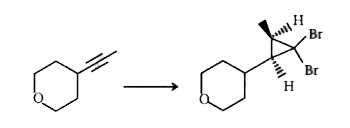Write steps to carry out the conversion of phenol to aspirin.
To convert phenol to aspirin, we will follow a two-step process involving the synthesis of salicylic acid followed by its acetylation. Here are the detailed steps:
Step 1: Conversion of Phenol to Salicylic Acid
1. Formation of Sodium Phenoxide:
- Start with phenol (C6H5OH).
- Treat phenol with sodium hydroxide (NaOH) to form sodium phenoxide (C6H5O⁻Na⁺).
- Reaction:
C6H5OH+NaOH→C6H5O−Na++H2O
2. Carboxylation of Sodium Phenoxide:
- Subject sodium phenoxide to carbon dioxide (CO2) at a temperature of 400 K and a pressure of 4 to 7 atm.
- This reaction is known as the Kolbe's electrolysis.
- Reaction:
C6H5O−Na++CO2→C6H4(OH)(COONa)(sodium salicylate)
3. Formation of Salicylic Acid:
- Add dilute hydrochloric acid (HCl) to the sodium salicylate to convert it to salicylic acid (C6H4(OH)(COOH)).
- This will lead to the removal of sodium chloride (NaCl) and water.
- Reaction:
C6H4(OH)(COONa)+HCl→C6H4(OH)(COOH)+NaCl+H2O
Step 2: Acetylation of Salicylic Acid to Form Aspirin
4. Acetylation:
- Take the salicylic acid obtained from the previous step.
- React it with acetic anhydride (C4H6O3) in the presence of an acid catalyst (H⁺, which can be H2SO4 or HCl).
- This will acetylate the hydroxyl group (-OH) of salicylic acid.
- Reaction:
C6H4(OH)(COOH)+(CH3CO)2OH+−−→C6H4(OCOCH3)(COOH)+CH3COOH
- The product is aspirin (acetylsalicylic acid, C6H4(OCOCH3)(COOH)).
Summary of the Reaction Sequence:
1. Phenol → Sodium Phenoxide → Sodium Salicylate → Salicylic Acid
2. Salicylic Acid + Acetic Anhydride → Aspirin
- Start with phenol (C6H5OH).
- Treat phenol with sodium hydroxide (NaOH) to form sodium phenoxide (C6H5O⁻Na⁺).
- Reaction:
C6H5OH+NaOH→C6H5O−Na++H2O
- Subject sodium phenoxide to carbon dioxide (CO2) at a temperature of 400 K and a pressure of 4 to 7 atm.
- This reaction is known as the Kolbe's electrolysis.
- Reaction:
C6H5O−Na++CO2→C6H4(OH)(COONa)(sodium salicylate)
- Add dilute hydrochloric acid (HCl) to the sodium salicylate to convert it to salicylic acid (C6H4(OH)(COOH)).
- This will lead to the removal of sodium chloride (NaCl) and water.
- Reaction:
C6H4(OH)(COONa)+HCl→C6H4(OH)(COOH)+NaCl+H2O
- Take the salicylic acid obtained from the previous step.
- React it with acetic anhydride (C4H6O3) in the presence of an acid catalyst (H⁺, which can be H2SO4 or HCl).
- This will acetylate the hydroxyl group (-OH) of salicylic acid.
- Reaction:
C6H4(OH)(COOH)+(CH3CO)2OH+−−→C6H4(OCOCH3)(COOH)+CH3COOH
- The product is aspirin (acetylsalicylic acid, C6H4(OCOCH3)(COOH)).
1. Phenol → Sodium Phenoxide → Sodium Salicylate → Salicylic Acid
2. Salicylic Acid + Acetic Anhydride → Aspirin
Topper's Solved these Questions
Similar Questions
Knowledge Check
- Question 1 - Select One

To carry out conversion reagent used in decreasing order.ANa/liq.NH3,ChBr3/NaOH(Δ)BH2/Pd−CaCO3,CHBr3/NaOH(Δ)CNa/liq.NH3,CHCl3/NaOHDH2/Pd−CaCO3,CHCl3/NaOH
Conversion of Phenol into Toluene .
View SolutionConversion of Phenol into salicylic acid
View SolutionConversion of Benzene to phenol
View SolutionConversion of Aniline to phenol
View SolutionHow will you convert phenol into aspirin ?
View SolutionCarry out the following conversions :
Ethanol to acetone.View SolutionConversion of Phenol into benzoic acid
View Solution

